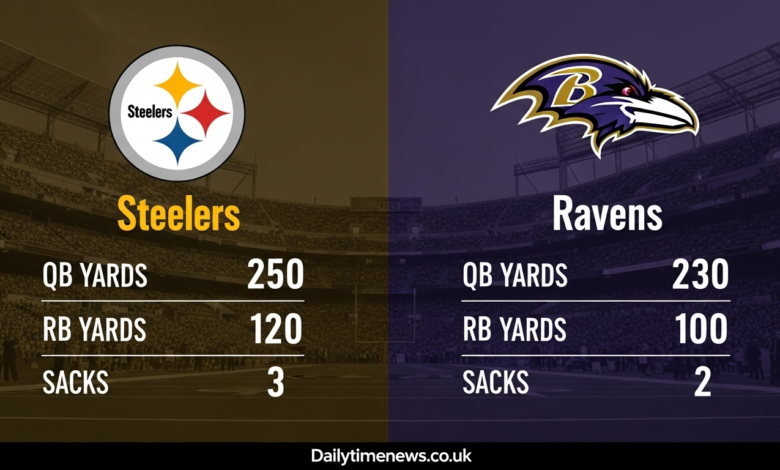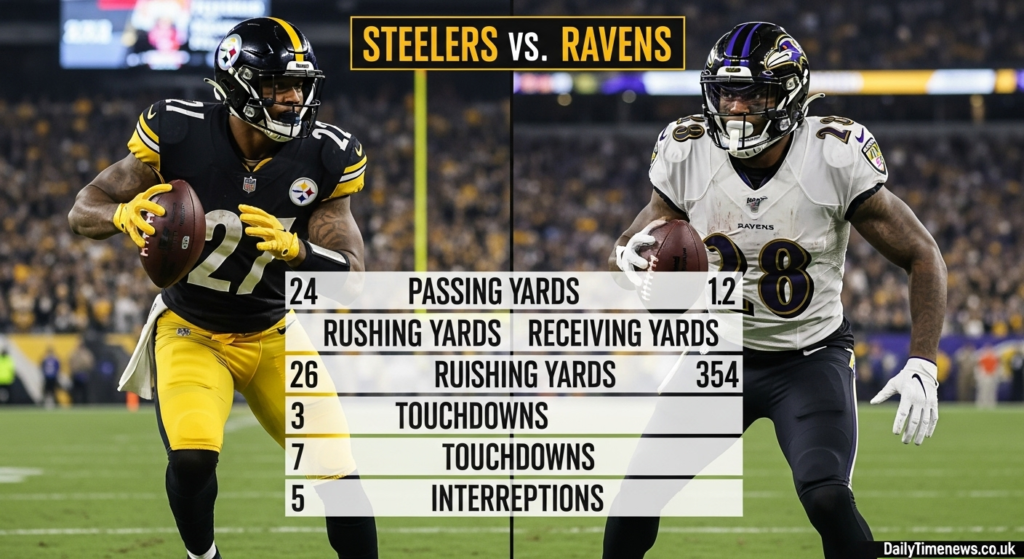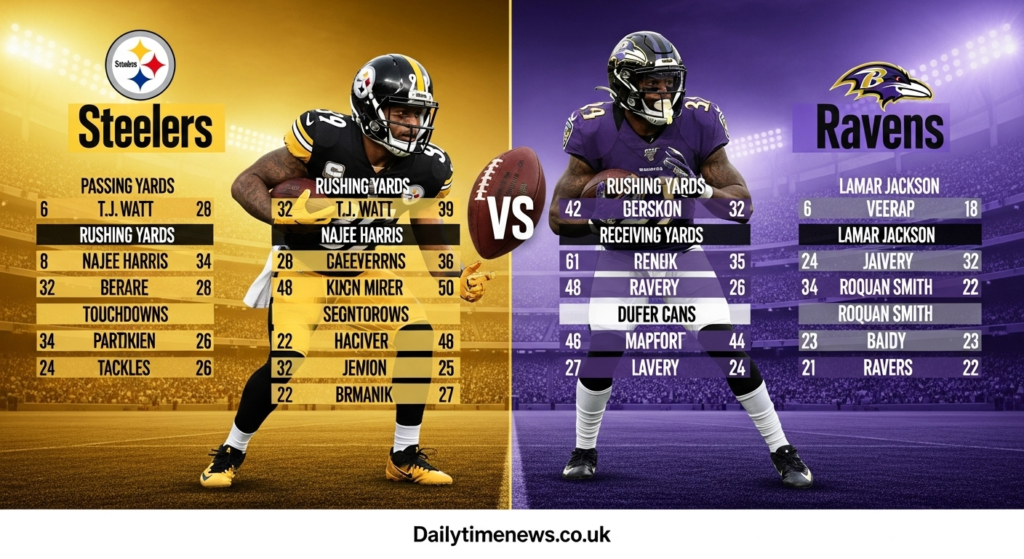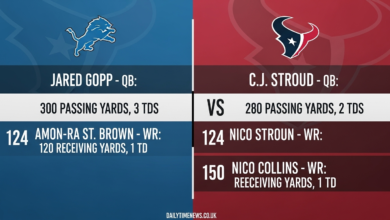Steelers vs Baltimore Ravens Match Player Stats Revealed

Introduction
You’re watching one of the NFL’s most intense rivalries unfold on your screen. The Pittsburgh Steelers and Baltimore Ravens are battling it out, and you want to know which players are making the difference. The Steelers vs Baltimore Ravens match player stats tell a story that goes beyond the final score.
These two teams have been rivals since the Ravens joined the AFC North in 1996. Every meeting between them feels like a playoff game. The physicality, the defensive battles, and the sheer intensity make these matchups unforgettable.
This article breaks down the player statistics from recent Steelers vs Ravens games. You’ll discover which quarterbacks dominated, which defenders made game-changing plays, and which special teams moments shifted momentum. We’ll analyze offensive production, defensive standouts, and the key stats that determined the outcomes.
Whether you’re a die-hard fan or just love great football, understanding these player stats gives you deeper insight into one of the NFL’s best rivalries.
The Historic Rivalry Between Pittsburgh and Baltimore
Understanding the Stakes
The Steelers and Ravens rivalry is built on decades of hard-hitting football. Both teams emphasize defense, physical play, and old-school football values. When they meet, records often go out the window.
Pittsburgh has dominated the all-time series, but Baltimore has made it competitive in recent years. The games are typically low-scoring, defensive struggles. Big plays and turnovers often decide winners.
Division games carry extra weight. Winning the AFC North often comes down to head-to-head matchups. Playoff positioning frequently depends on these rivalry games. The intensity reflects these high stakes.
Players on both teams understand what these games mean to their cities. Baltimore and Pittsburgh are blue-collar towns that take football seriously. The rivalry represents more than just wins and losses.
Recent History and Trends
The Steelers vs Baltimore Ravens match player stats from recent seasons show evolving dynamics. Baltimore’s offense has become more explosive with Lamar Jackson. Pittsburgh has maintained its defensive identity while developing offensive playmakers.
Home-field advantage matters significantly in this rivalry. The teams split their regular season series most years. Road wins are hard-earned and often come down to the final possession.
Playoff meetings have added extra layers to the rivalry. These postseason clashes produce legendary moments and heartbreaking defeats. The intensity reaches another level when championships are on the line.
Weather often plays a role, especially in late-season games. Cold, wet conditions suit both teams’ physical styles. These environmental factors show up in the player statistics.
Quarterback Performance Analysis
Lamar Jackson’s Impact
Lamar Jackson has redefined Baltimore’s offense since becoming the starter. His unique ability to run and pass creates challenges Pittsburgh’s defense hasn’t faced from other quarterbacks. The Steelers vs Baltimore Ravens match player stats consistently show Jackson’s dual-threat production.
Jackson’s rushing numbers against Pittsburgh are impressive. He often gains 60 to 100 yards on the ground while passing for 200-plus yards. His mobility extends plays and creates opportunities for receivers.
The Ravens design specific plays to leverage Jackson’s speed. Read-option concepts, designed quarterback runs, and bootlegs keep Pittsburgh’s defense off balance. Containing Jackson requires disciplined gap integrity.
However, Pittsburgh has had success forcing Jackson into difficult throws. The Steelers’ pass rush and coverage combinations sometimes limit his passing efficiency. His completion percentage and yards per attempt can drop against Pittsburgh’s defensive schemes.
Jackson’s touchdown to interception ratio varies in these matchups. Some games see him making spectacular plays. Others feature crucial turnovers that swing momentum. His performance often determines the game’s outcome.
Pittsburgh’s Quarterback Situation
Pittsburgh’s quarterback position has seen transitions in recent years. Ben Roethlisberger’s retirement ended an era. The Steelers have since worked to establish consistent quarterback play.
The Steelers vs Baltimore Ravens match player stats show that success at quarterback against Baltimore requires toughness. The Ravens’ defense brings constant pressure. Quarterbacks must make quick decisions and withstand physical punishment.
Pittsburgh’s quarterbacks typically emphasize efficiency over big plays against Baltimore. Short passing games, play-action concepts, and getting the ball out quickly help neutralize the Ravens’ pass rush.
Mobile quarterbacks have had more success extending plays against Baltimore’s aggressive defense. Scrambling ability creates second chances when primary reads are covered. This mobility helps sustain drives.
Whoever plays quarterback for Pittsburgh must excel at third-down conversions. Sustaining drives keeps Baltimore’s offense off the field. Ball security is paramount, as turnovers typically doom the Steelers in these matchups.
Running Back Showdowns
Baltimore’s Ground Game
The Ravens have built their offense around running the football. Their rushing attack ranks among the NFL’s best annually. The Steelers vs Baltimore Ravens match player stats regularly show Baltimore dominating time of possession through their ground game.
J.K. Dobbins, Gus Edwards, and other Ravens running backs have found success against Pittsburgh. Baltimore’s offensive line creates running lanes through physical blocking. Their zone-blocking scheme generates big plays.
The Ravens’ rushing yards per game against Pittsburgh typically exceed their season averages. They commit to running the ball even when trailing. This dedication to the ground game wears down Pittsburgh’s defense.
Individual running back stats show consistent production. Baltimore often has multiple backs gaining significant yardage. This committee approach keeps everyone fresh and limits Pittsburgh’s ability to key on one player.
Lamar Jackson’s presence adds another rushing dimension. Defenses must account for him on every play. This creates numerical advantages for the running backs. The combined rushing totals often exceed 200 yards.
Pittsburgh’s Rushing Attack
Pittsburgh has traditionally emphasized a strong running game. While recent years have seen more passing emphasis, they still value controlling the clock through rushing.
Najee Harris has become the focal point of Pittsburgh’s running attack. His physical running style fits perfectly against Baltimore’s tough defense. The Steelers vs Baltimore Ravens match player stats show Harris consistently getting 15 to 20 carries.
Pittsburgh’s rushing yards per carry against Baltimore are typically below league average. The Ravens’ defensive front is stout against the run. Creating consistent rushing lanes requires excellent blocking.
The Steelers use their running game to set up play-action passing. When they establish even modest rushing success, it opens opportunities downfield. Baltimore’s defense must respect the run threat.
Jaylen Warren and other complementary backs provide change-of-pace options. Their speed and receiving ability add versatility. Pittsburgh needs multiple backs contributing to sustain drives.

Wide Receiver and Tight End Statistics
Baltimore’s Receiving Corps
Mark Andrews has been Lamar Jackson’s most reliable target. The tight end consistently produces against Pittsburgh’s defense. His size and athleticism create matchup problems.
The Steelers vs Baltimore Ravens match player stats show Andrews often leading Baltimore in receptions and receiving yards. He’s particularly effective in the red zone. His touchdown numbers reflect his importance.
Rashod Bateman, Odell Beckham Jr., and other receivers have contributed at various times. Baltimore’s receiving corps has evolved, but the emphasis remains on getting Andrews involved.
Baltimore’s receivers must excel at contested catches. Pittsburgh’s physical secondary challenges every reception. Winning 50-50 balls is crucial for offensive success.
The Ravens use tight ends extensively in their offense. Multiple tight end sets create blocking advantages and passing options. This versatility stresses Pittsburgh’s defensive alignments.
Pittsburgh’s Pass Catchers
George Pickens has emerged as Pittsburgh’s top receiving threat. His ability to win downfield creates explosive play potential. The Steelers vs Baltimore Ravens match player stats show Pickens making impact catches.
Diontae Johnson has been consistent in previous matchups. His route running and sure hands make him reliable on third downs. He excels at creating separation in short areas.
Pat Freiermuth provides a safety valve at tight end. His size and hands make him effective in traffic. Pittsburgh targets him frequently on intermediate routes.
Pittsburgh’s receivers must be physical against Baltimore’s aggressive secondary. Press coverage and physical play challenge every route. Winning at the line of scrimmage is essential.
Allen Robinson and other veterans add experience and depth. Their ability to contribute when featured receivers are covered matters. Pittsburgh needs multiple receivers making plays.
Defensive Player Impact
Baltimore’s Defensive Standouts
Roquan Smith has transformed Baltimore’s defense since his arrival. The linebacker’s speed and instincts make him a playmaker. The Steelers vs Baltimore Ravens match player stats consistently show Smith leading in tackles.
Smith’s ability to diagnose plays quickly disrupts Pittsburgh’s offense. He excels in run defense and pass coverage. His versatility allows Baltimore to deploy various defensive schemes.
Kyle Hamilton provides playmaking ability from the safety position. His size allows him to cover tight ends effectively. He’s also a force in run support.
Baltimore’s edge rushers bring constant pressure. Whether it’s Odafe Oweh, David Ojabo, or others, Pittsburgh’s quarterbacks face relentless pass rush. Sacks and quarterback hits accumulate throughout games.
The Ravens’ secondary plays physical man coverage. Marlon Humphrey and other corners challenge receivers at the line. This aggressive style creates opportunities for turnovers.
Pittsburgh’s Defensive Force
T.J. Watt is Pittsburgh’s defensive centerpiece. When healthy, he’s arguably the NFL’s best pass rusher. The Steelers vs Baltimore Ravens match player stats show his impact through sacks, tackles for loss, and forced fumbles.
Watt’s presence affects how Baltimore’s offense operates. They must account for him on every play. Double teams and chip blocks are necessary but create opportunities for other Steelers defenders.
Minkah Fitzpatrick provides elite safety play. His ball skills and range allow Pittsburgh to play aggressive coverage. He’s made several game-changing interceptions against Baltimore.
Cameron Heyward anchors the defensive line. His consistency and leadership set the defensive tone. He clogs running lanes and generates interior pressure.
Alex Highsmith provides edge rushing opposite Watt. His development has made Pittsburgh’s pass rush even more dangerous. Offenses struggle when both edges bring heat simultaneously.
Special Teams Contributions
Kicking Game Importance
Chris Boswell has been clutch for Pittsburgh in tight games. His accuracy in pressure situations has won multiple Steelers-Ravens matchups. The Steelers vs Baltimore Ravens match player stats often show field goals deciding outcomes.
Boswell’s range allows Pittsburgh to attempt kicks from 50-plus yards. This extends their scoring opportunities. Three points matters significantly in low-scoring games.
Justin Tucker is arguably the NFL’s best kicker. His consistency and range give Baltimore confidence. He’s made several long kicks against Pittsburgh that shifted momentum.
Tucker’s accuracy from all distances makes Baltimore comfortable attempting field goals rather than going for it on fourth down. His presence affects coaching decisions.
Extra points and field goals carry extra pressure in rivalry games. The kickers’ mental toughness shows in clutch moments. Both Boswell and Tucker have delivered repeatedly.
Return Game Impact
Punt and kickoff returns can flip field position dramatically. Good returns set up short fields for offenses. Poor returns or turnovers on special teams often prove costly.
Both teams emphasize coverage excellence. Limiting return yardage forces opponents to drive the length of the field. Special teams discipline prevents big plays.
The Steelers vs Baltimore Ravens match player stats sometimes show special teams touchdowns. These momentum-changing plays can determine tight games. Coverage breakdowns or spectacular individual efforts create these opportunities.
Punting has been crucial in field position battles. Pinning opponents deep forces them to execute longer drives. Both teams employ skilled punters who excel at directional kicking.
Key Statistical Categories That Determine Winners
Turnover Differential
Turnovers typically decide Steelers-Ravens games. The team winning the turnover battle usually wins the game. Protecting the football is paramount for both offenses.
Interceptions, fumbles, and fumble recoveries show up prominently in the Steelers vs Baltimore Ravens match player stats. Star players on both sides have made game-changing takeaways.
Ball security begins with quarterback play. Careless throws or fumbled snaps can doom drives. Both teams emphasize protecting the football in practice.
Strip sacks and forced fumbles by defensive linemen and linebackers create turnovers. The physical nature of these games produces loose balls. Recovery often comes down to hustle and awareness.
Cornerbacks and safeties create interceptions through excellent coverage and ball skills. Defensive backs who can high-point the football and make contested catches give their teams extra possessions.
Third Down Conversions
Third down efficiency determines which offense sustains drives. Converting third downs extends possessions and wears down defenses. Failing on third down leads to punts and short fields for opponents.
The Steelers vs Baltimore Ravens match player stats show third down percentages often predict winners. Teams converting 40% or better typically control games. Those below 30% struggle to score.
Short yardage situations become critical battles. Third and one or third and two tests offensive line strength against defensive front toughness. These plays often determine momentum.
Third and long situations favor defenses. Both teams have aggressive pass rushes that pressure quarterbacks. Converting third and seven or longer requires excellent protection and playmaking.
Play calling on third down reveals coaching strategies. Some teams run more, others pass exclusively. Understanding tendencies helps defenses anticipate plays.
Time of Possession
Controlling the clock matters significantly in physical games. The team possessing the ball longer typically wins. Extended drives wear down opposing defenses.
Baltimore often dominates time of possession through their rushing attack. Long, methodical drives featuring numerous running plays consume clock. This keeps Pittsburgh’s offense on the sideline.
The Steelers vs Baltimore Ravens match player stats show correlation between time of possession and victory. Teams holding the ball 33 minutes or more usually win.
Conversely, quick three and outs hurt time of possession. Offenses that can’t sustain drives put their defenses in difficult positions. Fatigue becomes a factor in fourth quarters.
Two-minute drill efficiency also affects time management. Teams that execute quickly when trailing can overcome time of possession disadvantages. Clock management decisions become crucial.
Red Zone Performance
Scoring Efficiency Inside the 20
Red zone performance separates good offenses from great ones. Reaching the opponent’s 20-yard line without scoring wastes opportunities. Both teams emphasize finishing drives.
Touchdown percentages in the red zone vary by game. The Steelers vs Baltimore Ravens match player stats show these efficiency numbers fluctuating based on game plans and personnel.
Baltimore’s running game becomes even more effective in short fields. Defenses must defend the entire width of the field with less depth. This creates running lanes.
Pittsburgh’s passing game generates red zone touchdowns through size mismatches and precise routes. Tight ends and bigger receivers have advantages near the goal line.
Field goals instead of touchdowns can haunt teams in close games. Settling for three points when seven was possible often proves decisive. Red zone failures accumulate.
Defensive Red Zone Stands
Preventing touchdowns in the red zone wins games. Forcing field goals creates four-point swings compared to allowing touchdowns. Defensive stands provide momentum.
Both defenses play with extra intensity inside their 20-yard line. The compressed field helps defenders. Offenses have less space to work with.
Goal line stands have decided several Steelers-Ravens games. Fourth down stops from inside the five create massive momentum swings. These plays become legendary moments.
The Steelers vs Baltimore Ravens match player stats show red zone defensive efficiency correlating with victories. Teams holding opponents below 50% touchdown rates usually win.
Injury Impact on Player Statistics
Key Injuries Affecting Games
Injuries to star players dramatically affect outcomes. When T.J. Watt or Lamar Jackson miss games, the dynamics change completely. Backup players must step up.
Pittsburgh’s defense struggles without Watt’s pass rush. Offenses face less pressure and have more time to throw. His absence affects multiple statistical categories.
Baltimore’s offense becomes one-dimensional without Jackson. Backup quarterbacks lack his unique running ability. The entire offensive system must adjust.
Injuries to offensive linemen affect protection and running game effectiveness. The Steelers vs Baltimore Ravens match player stats often reflect these personnel losses through rushing yards and sacks allowed.
Both teams have depth, but star player absences create noticeable declines. Understanding who’s playing helps interpret statistical performances.
Playing Through Pain
Many players compete despite injuries in rivalry games. Their toughness reflects the game’s importance. However, injuries limit effectiveness.
Quarterbacks playing through shoulder or rib injuries may have reduced arm strength. This affects deep ball accuracy and completion percentages. Stats might not reflect their usual standards.
Running backs dealing with ankle or knee issues show reduced explosiveness. Their yards per carry averages drop. They might still play significant snaps but with diminished production.
Receivers with hand or finger injuries have difficulty catching. Their drop rates increase. These subtle injury impacts appear in the statistics.
Coaching Decisions Reflected in Stats
Offensive Play Calling
Mike Tomlin and John Harbaugh make strategic decisions affecting player statistics. Their offensive philosophies shape how games unfold.
Baltimore’s commitment to running produces impressive rushing stats but sometimes limits passing numbers. This balance reflects Harbaugh’s vision for ball control offense.
Pittsburgh’s play calling adapts to opponent tendencies. Some games feature pass-heavy approaches. Others emphasize running to control tempo. The Steelers vs Baltimore Ravens match player stats reflect these strategic choices.
Fourth down decisions affect statistical outcomes. Aggressive fourth down attempts can boost stats or result in turnovers on downs. Conservative approaches limit possessions but protect field position.
Defensive Schemes
Defensive coordinators adjust schemes based on opponent strengths. These adjustments affect which players accumulate statistics.
Baltimore sometimes uses more defensive backs against pass-heavy opponents. This affects linebacker snap counts and tackle statistics. Safety and cornerback numbers increase.
Pittsburgh occasionally employs extra pass rushers to pressure mobile quarterbacks. This creates sack opportunities but might sacrifice run defense. The statistical trade-offs reflect strategic priorities.
Blitz frequencies affect multiple statistical categories. Heavy blitzing produces more sacks but also allows more big plays. Conservative rush approaches limit both.
Fan Perspective and Memorable Performances
Legendary Individual Performances
Certain individual performances live in rivalry lore. These exceptional stat lines become legendary among fans. They represent pinnacle achievements in meaningful games.
Troy Polamalu’s defensive dominance created unforgettable moments. His interceptions, forced fumbles, and tackles for loss in crucial games exemplify defensive excellence. Ravens fans remember these performances painfully.
Ray Lewis’s intensity against Pittsburgh defined his career. His tackle numbers and leadership in rivalry games created lasting legacies. Steelers fans respected his greatness while hating playing against him.
Big Ben’s clutch performances in Baltimore demonstrated his competitive fire. His late-game heroics and touchdown passes in hostile environments created memorable victories.
The Steelers vs Baltimore Ravens match player stats from these legendary performances still spark debates among fans. Who had the best single game? Which performance meant most?
What Fans Watch For
Die-hard fans track specific matchups within games. They know which position battles determine outcomes. Understanding these micro-battles enhances viewing experience.
The Watt versus left tackle matchup draws intense attention. Can the tackle slow Watt’s pass rush? How many times does Watt win?
Lamar Jackson versus Pittsburgh’s defense creates fascinating chess matches. Can the defense contain his mobility? Will he make game-changing throws?
Offensive line battles in the trenches determine rushing success. Fans watch for which line dominates. Physical play in these matchups reflects the rivalry’s nature.
Special teams execution provides emotional highs and lows. Blocked punts, long returns, or missed kicks create immediate reactions. These plays swing momentum dramatically.

Conclusion
The Steelers vs Baltimore Ravens match player stats tell rich stories about one of football’s best rivalries. Every game produces standout performances, defensive battles, and strategic chess matches between elite coaches.
Understanding these statistics deepens your appreciation for the rivalry. The numbers reveal which players rose to the occasion and which strategic approaches worked. They explain why certain games unfolded as they did.
Quarterback play, defensive dominance, turnover margins, and special teams execution consistently determine outcomes. The teams that excel in these areas usually emerge victorious. Physical play and mental toughness separate winners from losers.
As the rivalry continues evolving, new stars will create their own statistical legacies. Lamar Jackson, T.J. Watt, and current players are writing new chapters. Future games will add to the rich history.
Next time these teams meet, you’ll watch with greater understanding. You’ll recognize which stats matter most and which players to watch. The numbers enhance your enjoyment of this physical, intense rivalry.
Which player performance impressed you most in recent Steelers-Ravens matchups? What statistics do you consider most important in determining winners? Share your thoughts and keep following this incredible rivalry.
FAQs
Who typically has better stats in Steelers vs Ravens games? The stats vary by game, but both teams emphasize defense, leading to lower offensive numbers than their season averages. Baltimore often dominates rushing statistics, while Pittsburgh focuses on efficient passing and defensive takeaways.
How does Lamar Jackson perform against Pittsburgh? Lamar Jackson averages solid rushing yards against Pittsburgh, often exceeding 70 yards on the ground. His passing efficiency varies, with some excellent performances and some games where Pittsburgh’s defense limits his effectiveness through pressure and coverage.
What defensive stats matter most in this rivalry? Sacks, tackles for loss, turnovers, and third down stops are the most impactful defensive statistics. The team generating more pressure and creating more turnovers typically wins these low-scoring, defensive battles.
How important are running back stats in Steelers-Ravens games? Very important. Both teams emphasize physical running games that control clock and wear down defenses. Running backs who exceed 80 to 100 yards significantly increase their team’s winning percentage.
Do special teams stats affect game outcomes? Absolutely. Field position battles are crucial in low-scoring games. Kicking accuracy, punt coverage, and return yardage all impact outcomes. Both teams feature elite kickers whose field goals often decide winners.
Which offensive line performs better statistically? Baltimore’s offensive line typically generates better rushing statistics through their zone-blocking scheme. Pittsburgh’s line excels at pass protection but sometimes struggles creating consistent running lanes against Baltimore’s defensive front.
How do weather conditions affect player stats? Cold, wet, or snowy conditions reduce passing efficiency and increase rushing attempts. Both teams adapt well to poor weather, but completion percentages drop and fumbles increase in adverse conditions.
What receiving stats stand out in this rivalry? Tight end production is particularly important. Mark Andrews for Baltimore and Pat Freiermuth for Pittsburgh often lead their teams in receptions and receiving yards during these matchups due to their size advantages.
How does home field advantage show in the stats? Home teams typically have better third down conversion rates and fewer penalties. Crowd noise affects communication and timing, showing up in false start penalties and offensive efficiency metrics.
What historical player stats define this rivalry? Ray Lewis’s tackle numbers, Troy Polamalu’s interceptions and forced fumbles, Ben Roethlisberger’s fourth quarter comebacks, and Terrell Suggs’s sacks represent legendary statistical achievements that defined different eras of the rivalry.
Also Read Dailytimenews.co.uk




